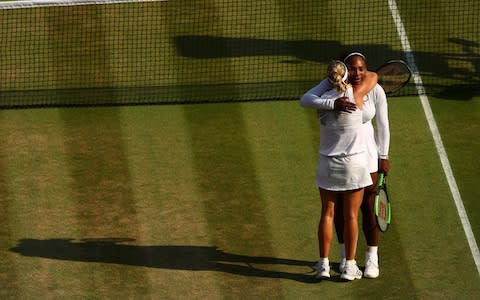Once the men’s semi-finals had finally concluded – a mere 26-and-a-half hours after they began – Angelique Kerber reminded everyone at Wimbledon that tennis can be short and sweet as well as long and arduous.
Kerber needed just 65 minutes to upend the narrative of this fortnight and eject the undeniable heroine of SW19 – Serena Williams – in straight sets.
Dramatic tension might have been lacking during her 6-3, 6-3 victory but the shock factor was huge.
Williams choked up with tears as she spoke to Sue Barker at the presentation ceremony. She has talked all fortnight of the responsibility she felt to all the mothers of the world, and her desire to be a role model for them to follow.
Some might have wondered whether she really meant those things, or whether she was simply out for the glory of an eighth Wimbledon title – which would, incidentally, have carried her level with Margaret Court’s all-time record of 24 majors. But after this emotional post-match interview, the argument is surely settled.
“For all the mums out there, I was playing for you today and I tried really hard,” said Williams, her bottom lip wobbling in a manner that will surely convert a new generation of fans. During her most exalted spells at the top of the game, she has sometimes come across as untouchable and intimidating, but this was a very humanising moment. We have seen with other tennis champions how the heartfelt emotions of defeat can bring a new approachability to their public image.

Kerber’s profile has been contrastingly low. Even in her home country of Germany, she is barely recognised in the street, despite having won both hard-court majors in her previous annus mirabilis of 2016. But that, too, might be about to change.
It is often said that the German tennis boom of the late 1980s – when Boris Becker and Steffi Graf were at their peak – provided the finance for the redevelopment of the Wimbledon grounds because of the amazing sums broadcasters such as RTL were prepared to pay for television rights. Yet no German had lifted a title here since Graf’s swansong in 1996.
“My first memories was watching Steffi here,” said Kerber afterwards, while pointing joyfully at the purple badge that confirmed her as a new member of the All England Club. “She was winning all the matches in two sets actually. I just remember that everybody was playing in white on the grass court. I think Wimbledon is something special. I think it’s traditional. To win here is forever. Nobody can take the title away from me now.”
She plays an understated game, too, with a shot put-style serve that barely gets over 100mph, and a frying-pan forehand. But those legs! They used to be known as the second strongest on the tour, behind those of the Amazonian Williams. Yet while Williams continues to work her way back towards optimal physical conditioning, Kerber has become the ultimate roadrunner.
How do you beat Williams? The evidence suggests that it is not the big-hitters who usually get the job done. It is those who run every ball down and force her to play an extra shot or three.
Kim Clijsters, back in the day, had success with this tenacious approach. So did Jelena Jankovic. But Kerber has now beaten Williams twice in major finals – a boast no one except sister Venus Williams has ever been able to make before.
The Duchesses of Cambridge and Sussex attend Wimbledon ladies’ final day
The previous instance came at the 2016 Australian Open final, when Kerber touched out a 6-4, 3-6, 6-4 victory that left a significant psychological imprint. That remains the only time Williams has lost a major final in three sets, and it established a precedent. Both players went into Saturday’s match knowing Kerber would simply refuse to be bullied off the court by Williams’s body language and aura.
Williams has made two comebacks since the complicated birth of her daughter Olympia in September. The first one – which came in Indian Wells and Miami in March – was essentially a toe-in-the-water exercise. The second, which began at Roland Garros seven weeks ago, had previously delivered nine straight wins and one withdrawal, on account of the right pectoral injury she sustained in Paris.
But how often had Williams been tested? At Wimbledon, she had dropped only one previous set and that came against Camila Giorgi, a fast-swinging, short-rally sort of player.
The obdurate Kerber provided a dramatic contrast, and required Williams to cover so much more ground. She was breathing hard from early on and the absence of many cheap points gave her little chance to recover.

Kerber proved herself to be the female Novak Djokovic here as she returned serve with extraordinary accuracy. Before the final, just over half of Williams’s serves had won the point on their own. In this match, 80 per cent came back, and once the baseline rallies began, Kerber was irresistible.
Tennis matches are so often won and lost through mistakes, but Kerber’s unforced error tally on Saturday stood at a miserly five.
Early in the second set, Williams tried to rouse herself. She became more vocal, came to the net more often, and even went for a “tube” – tennis jargon for the bodyline shot straight at your opponent. But Kerber dodged out of the way, just as she dodged trouble all afternoon. The ball flew long in what felt like a metaphor for the match.
During her post-match press conference, Williams was asked about the scheduling decision to delay the women’s final until after the men had finished. Her answer, like her on-court interview, showed great poise.
“I just feel like it was a necessary evil,” Williams replied. “Not knowing how [long] this match would go, I don’t think they could put the men’s semi-final behind the women because they have to come back the next day.
“If the tables were turned, hopefully they would have done the same with the women. But if you look at it that way, it was probably really the only way to schedule it.”














